Yuhuan Yang
ReMamber: Referring Image Segmentation with Mamba Twister
Mar 26, 2024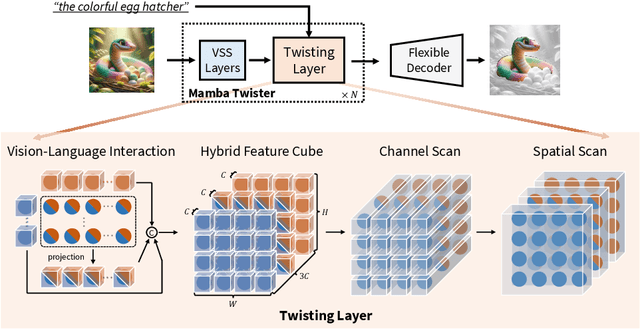
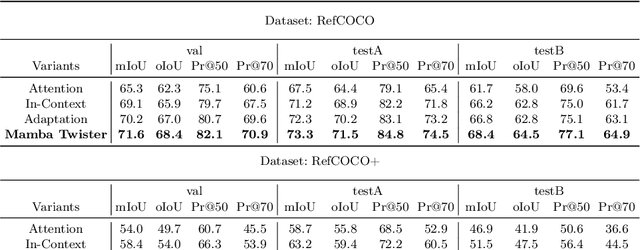
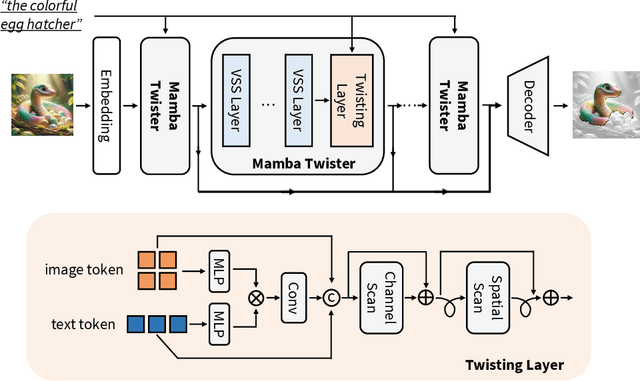
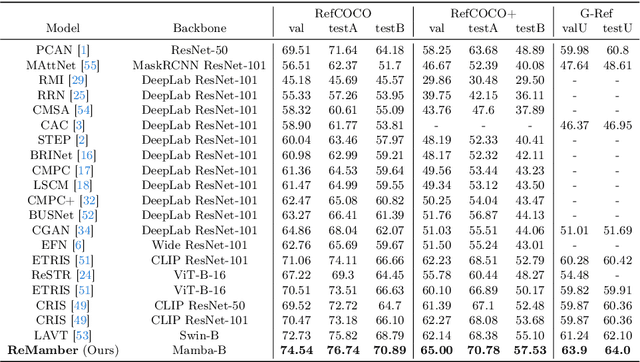
Abstract:Referring Image Segmentation (RIS) leveraging transformers has achieved great success on the interpretation of complex visual-language tasks. However, the quadratic computation cost makes it resource-consuming in capturing long-range visual-language dependencies. Fortunately, Mamba addresses this with efficient linear complexity in processing. However, directly applying Mamba to multi-modal interactions presents challenges, primarily due to inadequate channel interactions for the effective fusion of multi-modal data. In this paper, we propose ReMamber, a novel RIS architecture that integrates the power of Mamba with a multi-modal Mamba Twister block. The Mamba Twister explicitly models image-text interaction, and fuses textual and visual features through its unique channel and spatial twisting mechanism. We achieve the state-of-the-art on three challenging benchmarks. Moreover, we conduct thorough analyses of ReMamber and discuss other fusion designs using Mamba. These provide valuable perspectives for future research.
Open-Vocabulary Semantic Segmentation via Attribute Decomposition-Aggregation
Aug 31, 2023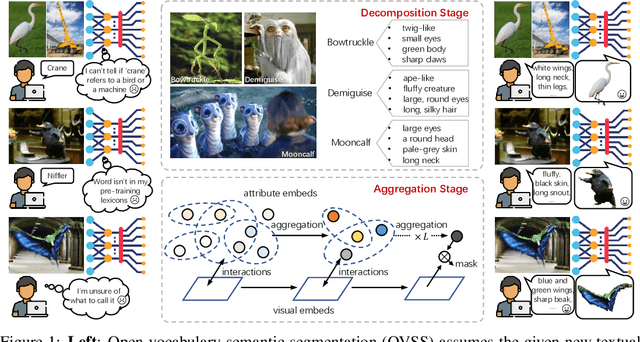



Abstract:Open-vocabulary semantic segmentation is a challenging task that requires segmenting novel object categories at inference time. Recent works explore vision-language pre-training to handle this task, but suffer from unrealistic assumptions in practical scenarios, i.e., low-quality textual category names. For example, this paradigm assumes that new textual categories will be accurately and completely provided, and exist in lexicons during pre-training. However, exceptions often happen when meet with ambiguity for brief or incomplete names, new words that are not present in the pre-trained lexicons, and difficult-to-describe categories for users. To address these issues, this work proposes a novel decomposition-aggregation framework, inspired by human cognition in understanding new concepts. Specifically, in the decomposition stage, we decouple class names into diverse attribute descriptions to enrich semantic contexts. Two attribute construction strategies are designed: using large language models for common categories, and involving manually labelling for human-invented categories. In the aggregation stage, we group diverse attributes into an integrated global description, to form a discriminative classifier that distinguishes the target object from others. One hierarchical aggregation is further designed to achieve multi-level alignment and deep fusion between vision and text. The final result is obtained by computing the embedding similarity between aggregated attributes and images. To evaluate the effectiveness, we annotate three datasets with attribute descriptions, and conduct extensive experiments and ablation studies. The results show the superior performance of attribute decomposition-aggregation.
Multi-Modal Prototypes for Open-Set Semantic Segmentation
Jul 05, 2023Abstract:In semantic segmentation, adapting a visual system to novel object categories at inference time has always been both valuable and challenging. To enable such generalization, existing methods rely on either providing several support examples as visual cues or class names as textual cues. Through the development is relatively optimistic, these two lines have been studied in isolation, neglecting the complementary intrinsic of low-level visual and high-level language information. In this paper, we define a unified setting termed as open-set semantic segmentation (O3S), which aims to learn seen and unseen semantics from both visual examples and textual names. Our pipeline extracts multi-modal prototypes for segmentation task, by first single modal self-enhancement and aggregation, then multi-modal complementary fusion. To be specific, we aggregate visual features into several tokens as visual prototypes, and enhance the class name with detailed descriptions for textual prototype generation. The two modalities are then fused to generate multi-modal prototypes for final segmentation. On both \pascal and \coco datasets, we conduct extensive experiments to evaluate the framework effectiveness. State-of-the-art results are achieved even on more detailed part-segmentation, Pascal-Animals, by only training on coarse-grained datasets. Thorough ablation studies are performed to dissect each component, both quantitatively and qualitatively.
DiffusionSeg: Adapting Diffusion Towards Unsupervised Object Discovery
Mar 17, 2023
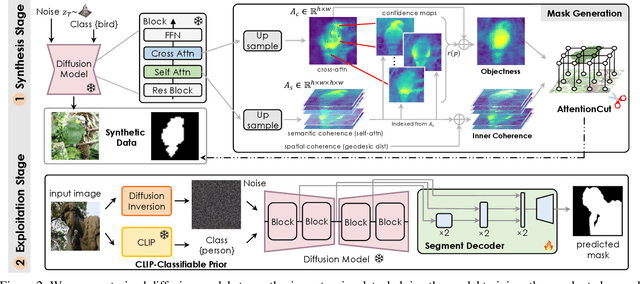


Abstract:Learning from a large corpus of data, pre-trained models have achieved impressive progress nowadays. As popular generative pre-training, diffusion models capture both low-level visual knowledge and high-level semantic relations. In this paper, we propose to exploit such knowledgeable diffusion models for mainstream discriminative tasks, i.e., unsupervised object discovery: saliency segmentation and object localization. However, the challenges exist as there is one structural difference between generative and discriminative models, which limits the direct use. Besides, the lack of explicitly labeled data significantly limits performance in unsupervised settings. To tackle these issues, we introduce DiffusionSeg, one novel synthesis-exploitation framework containing two-stage strategies. To alleviate data insufficiency, we synthesize abundant images, and propose a novel training-free AttentionCut to obtain masks in the first synthesis stage. In the second exploitation stage, to bridge the structural gap, we use the inversion technique, to map the given image back to diffusion features. These features can be directly used by downstream architectures. Extensive experiments and ablation studies demonstrate the superiority of adapting diffusion for unsupervised object discovery.
Open-vocabulary Semantic Segmentation with Frozen Vision-Language Models
Oct 27, 2022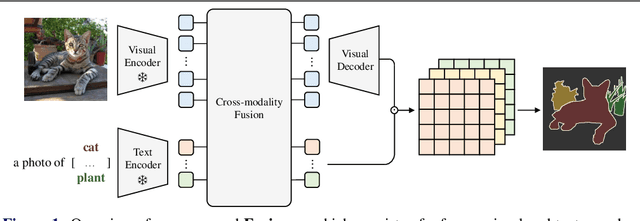
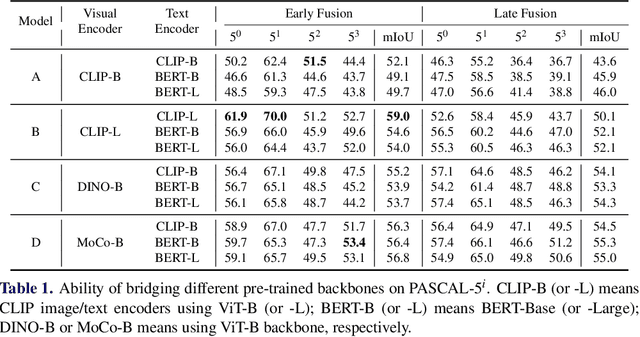


Abstract:When trained at a sufficient scale, self-supervised learning has exhibited a notable ability to solve a wide range of visual or language understanding tasks. In this paper, we investigate simple, yet effective approaches for adapting the pre-trained foundation models to the downstream task of interest, namely, open-vocabulary semantic segmentation. To this end, we make the following contributions: (i) we introduce Fusioner, with a lightweight, transformer-based fusion module, that pairs the frozen visual representation with language concept through a handful of image segmentation data. As a consequence, the model gains the capability of zero-shot transfer to segment novel categories; (ii) without loss of generality, we experiment on a broad range of self-supervised models that have been pre-trained with different schemes, e.g. visual-only models (MoCo v3, DINO), language-only models (BERT), visual-language model (CLIP), and show that, the proposed fusion approach is effective to any pair of visual and language models, even those pre-trained on a corpus of uni-modal data; (iii) we conduct thorough ablation studies to analyze the critical components in our proposed Fusioner, while evaluating on standard benchmarks, e.g. PASCAL-5i and COCO-20i , it surpasses existing state-of-the-art models by a large margin, despite only being trained on frozen visual and language features; (iv) to measure the model's robustness on learning visual-language correspondence, we further evaluate on synthetic dataset, named Mosaic-4, where images are constructed by mosaicking the samples from FSS-1000. Fusioner demonstrates superior performance over previous models.
Transforming the Interactive Segmentation for Medical Imaging
Aug 20, 2022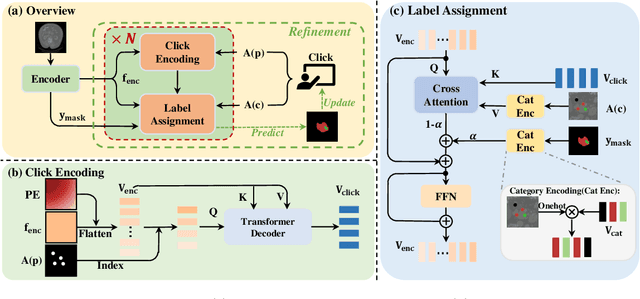



Abstract:The goal of this paper is to interactively refine the automatic segmentation on challenging structures that fall behind human performance, either due to the scarcity of available annotations or the difficulty nature of the problem itself, for example, on segmenting cancer or small organs. Specifically, we propose a novel Transformer-based architecture for Interactive Segmentation (TIS), that treats the refinement task as a procedure for grouping pixels with similar features to those clicks given by the end users. Our proposed architecture is composed of Transformer Decoder variants, which naturally fulfills feature comparison with the attention mechanisms. In contrast to existing approaches, our proposed TIS is not limited to binary segmentations, and allows the user to edit masks for arbitrary number of categories. To validate the proposed approach, we conduct extensive experiments on three challenging datasets and demonstrate superior performance over the existing state-of-the-art methods. The project page is: https://wtliu7.github.io/tis/.
 Add to Chrome
Add to Chrome Add to Firefox
Add to Firefox Add to Edge
Add to Edge